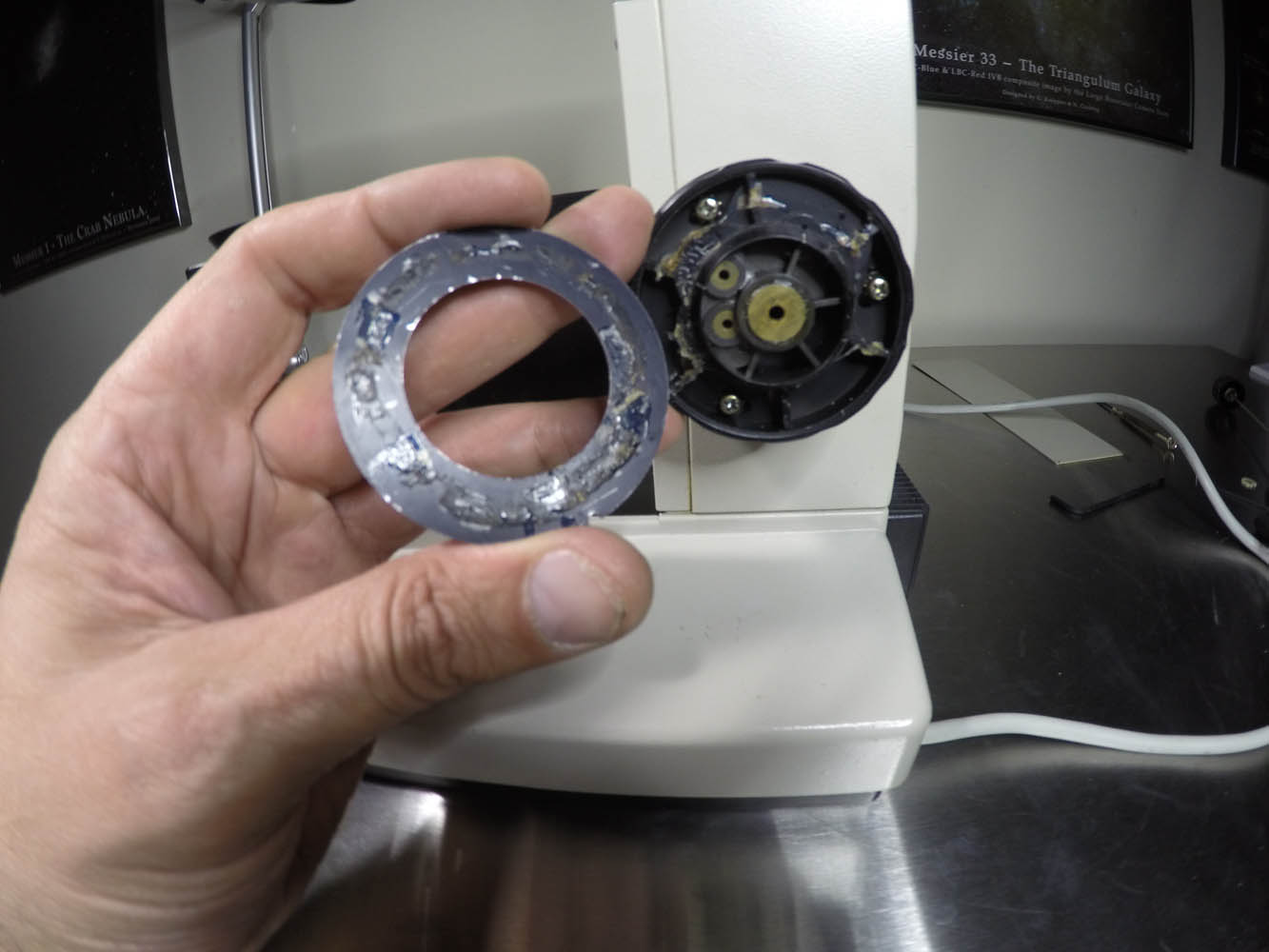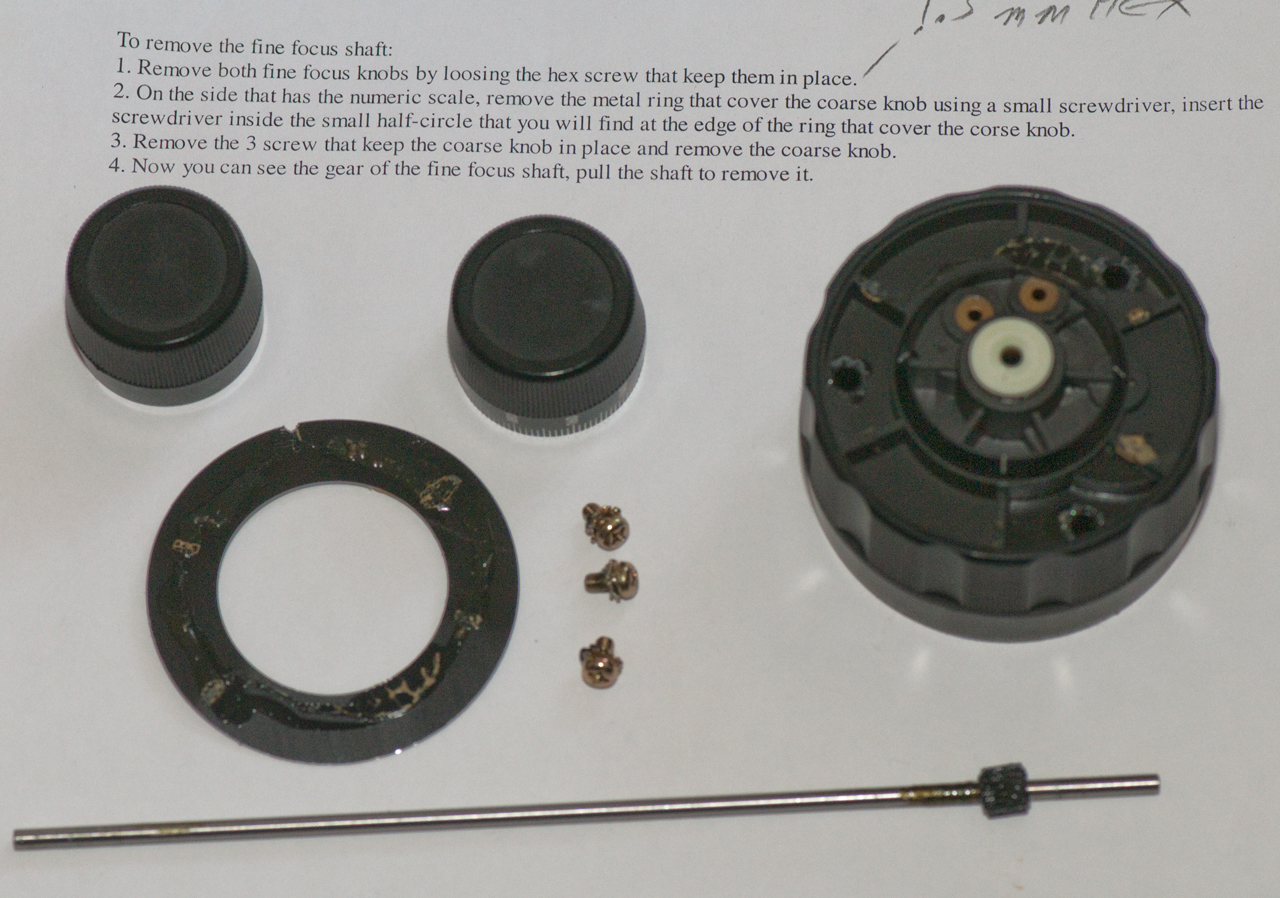back

Nikon Labophot Microscope
Introduced around the same time as the Optiphot (1978), the Labophot is lower cost and less flexible.
Positioned for labs rather than research, many are configured for phase contrast.
Nikon 221403 Labophot Microscope Parts Only (S1084)
eBay item number: 155061301918
Condition: For parts or not working
Manufacturer: Nikon
Nikon 221403 Labophot Microscope Parts Only (S1084)
"No power."
Received 11 July 2022
Base casting broken next to illuminator;
potentiometer broken.
Common (grounded) emitter bipolar transistors are approximately constant current sources.
Labophot and Optiphot use transistors to modulate halogen lamp power
and variable resistors between base and collector for control.
Labophot potentiometers are about 1K Ohms, connected between collector and base,
with halogen lamp between collector and nominal +7 VDC,
to accommodate incandescent lamp behavior:
- As filament heats, resistance increases.
- This lowers voltage drop from collector to emitter
and also current thru resistor to base, reducing power to lamps.
- 20W halogen lamps start dimly illuminating with nearly 1A current,
which may be LED maximum.

Currents were measured using a CA-60 AC/DC clamp.

LEDs behave differently:
- For the (2N3716) transistor to work as a nearly constant current source,
reconfigure variable resistor as a voltage divider between +/-Vcc
with wiper to base, causing negative feedback
as base-to-emitter voltage increases with current.
- Selected LED should be bright enough with 1A
that 0.65V is maximum base Voltage;
680 Ohms above 1K potentiometer should sufficiently limit current;
need to determine minimum base drive for useful brightness.
to establish resistance between 1K potentiometer and ground.
- LED will drop nearly constant 6V; transistor will dissipate < 1W.
- Above some voltage threshold, current increases with temperature.
- this effectively decreases resistance
increasing transistor collector-emitter voltage and current
thru collector-base resistance, provoking current runaway.
- Supply Voltage Vcc droops slightly with increased current,
providing slight stabilizing negative feedback.
# Labophot, Optiphot 66 halogen measurements 12 July, 9 Sept 2022
# collector base lamp base lamp
# dial Vcc yellow brown mA mA V
OFF 10 0 0
1 7.6 6.94 .64 770 0 .2
1.5 7.51 6.9 .64 770 0 .2
2 7.5 6.6 .65 910 9 .3 # very dim
2.5 7.36 6 .68 1180 11 .6
3 7.25 5.3 .70 1520 17 1.2
3.5 7.19 5 .71 1690 18 1.5
4 7.12 4.6 .73 1850 22.5 1.85
4.5 7.06 4 .74 2110 26 2.4
5 6.95 3.2 .78 2430 34 3.3
5.5 6.8 2 .81 2870 47 4.5
6 6.6 0.9 .85 3170 69 5.5
Francisco made an LED replacement similar to my intent.
For 5W LED instead of 20W halogen,
replace 1K variable resistor between 2N3716 collector and base,
which supplies a minimum of 1mA forward bias,
rewiring the potentiometer as a voltage divider with:
680 Ohms in series between CW and +Vcc (about 8VDC),
wiper to base, and
CCW to -Vcc |
 |

|
Fine Focus
- Labophot 2 and Optiphot 2 have different fine focus gear (4mm shaft, 16 teeth)
- This description is specific to original Labophot and Optiphot (3mm shaft, 18 teeth)
Other Nikon fine focus discussions:
Lothar Lothman was among the first to sort Labophot pinion gear 3mm bore 18 tooth module 0.3 spec.
http://www.photomacrography.net: Some progress in the repair of the Labophot 1
Only 2 of 6 Nikon finite CF microscope frames acquired had intact fine focus;
broken focus on others had split polymer pinion gears,
losing grip on flat in shaft flat, for which symptions are:
- no effect from turning fine focus knobs
- turning coarse focus knobs having no or inconsistent effect
- stage settling without knob motion
- turning coarse focus knob when stage is at a limit NOT provoking fine focus knob spin
To understand how Labophot/Optiphot stage focus works, first consider planetary gears:
 ... if either sun or planet gear were not fixed,
... if either sun or planet gear were not fixed,
then torque could not be transmitted.
While a polymer gear may be damaged by exceedingly stiff focus rack
e.g. from dried grease,
damage more likely occurs when users twist fine focus
while focus rack is against a stop
while coarse focus at opposite side is held.
Some Optiphots and Labophots have different fine focus gear trains:
0.2mm per rotation with a single large planetary gear
0.1mm per revolution with an idler gear train

0.2mm per rotation planetary gear on left; 0.1mm per rotation idler gear train on right
Both employ the same fragile polymer fine focus pinion gear:

This diagram is for Labophot/Optiphot stage focus employing single large planetary fine focus gear (125):

not shown above: polymer washers between both fine and coarse focus knobs, wave washer on gearcase side.
- a fine focus shaft(111), innermost
- a coarse focus tube(108) to which knob(104) and brass gearcase(107) attach, coaxial to fine focus shaft
- a pinion gear tube(109) with sun gear(123), driving
- a stage focus rack(9), where
- The fine focus shaft wave (spring) washer and grease apply resistance to coarse knobs via delrin washers.
- If/when a fine focus pinion gear(128) splits or otherwise loses grip on its shaft,
then planetary gear train (124-127) cannot transmit torque to pinion gear tube for focusing.


Single large planetary gear, as in Optiphot-66, wants pinion gear on fine focus shaft within 1mm of brass gearcase(107).
Fine focus pinion gear repair/replacement
If replacing Nikon's polymer fine focus pinion gear with a narrower spur gear, positioning becomes more critical.
- loosen (but do not remove) fine focus knob set screws using 1.3mm hex key

- remove fine focus knobs without grasping coarse focus grips;
do NOT attempt to remove left-hand coarse focus or brass planetary gearcase from their threaded tube;
they are secured by thread locker with tension adjusted to resist stage droop.
- Polymer threads in left coarse focus knob will be destroyed by unscrewing it.
- pry loose thin metal cover that is glued over screws on right coarse focus grip

- remove 3 screws fastening right coarse focus plastic grip to planetary gear case
- withdraw fine focus shaft with pinion gear

- degrease and dry pinion gear and that end of the fine focus shaft

- secure replacement pinion gear to shaft
(step 8 here)
with blue thread locker for metal gear; 2-part epoxy for polymer.
Nikon's polymer pinion gears are about 6mm wide;
narrower metal gears must be carefully located to mesh planetary gears:
- Some tweaking is possible by loosening fine focus knob set screws and sliding knobs on shaft flats;
additional tweaking by moving wavy washer from one side to the other.
- Center fine focus shaft flat on end opposite planetary gearcase about 10mm from coarse focus:

- Pinion gear flat should be about 1mm from gearcase:
 For idler gear train (instead of single large planetary gear),
For idler gear train (instead of single large planetary gear),
narrower metal pinion gear should be spaced about 3mm from gearcase for full engagement;
this example wants more space to fully engage:

To engage idler gear train, this spur gear wants extended hub towards gearbox:

- Before securing, move pinion gear between gearcase and flat
so that adhesive fluid on flat gets smeared away from the gearcase:

- Pinion for idler gears should be 18mm from end of fine focus shaft:

- reinstall fine focus shaft after pinion gear is secured
- grease pinion gear and wavy washer
- reinstall coarse focus plastic grip and metal cover
- install fine focus knobs, partially compressing wavy washer and tightening set screws,
without gripping coarse focus.
|

 ... if either sun or planet gear were not fixed,
... if either sun or planet gear were not fixed,





















